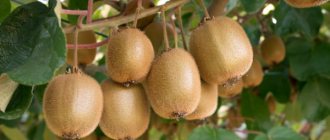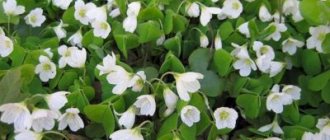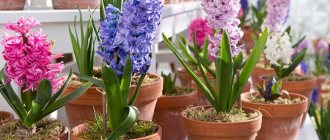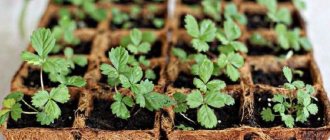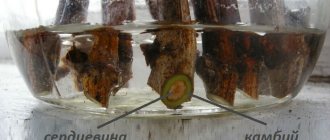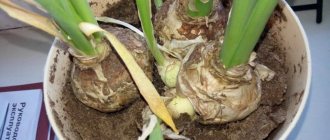Author of the article
Daria Vorontsova
Reading time: 10 minutes
AA
In early spring, crocuses blooming on the windowsill are the perfect decoration for a room, symbolizing the arrival of warmth and spring.
These delicate primroses can safely be called unique, because it is from the petals of some varieties of crocuses that the most valuable and expensive spice in the world - saffron - is made.
Growing crocuses at home is quite simple; these perennial flowers are relatively unpretentious and do not require a lot of money and effort. With the right approach, growing saffron on a windowsill will bring real pleasure and help decorate your home with delicate flowers.
Crocus or saffron: description of the flower
These are representatives of the Iris family - perennial corms resistant to cold. Their flowers are shaped like a glass, a star or a bowl .
The grass-like leaf is often crossed by a white vein. Note! In the evening and in cloudy weather, the flower petals close.
Most crocuses are single-flowered, but there are species with two or more flowers. Thanks to simple care before, during and after budding, these specimens are grown not only in flower beds, but also in the house.
8.Note, interesting facts
Crocus stigmas are used to make seasonings (another name is saffron) and for medicinal purposes.
In Europe, crocus became a symbol of wealth and superiority, as it was worth fabulous money as a seasoning. The flower is often used as a heraldic symbol - it is depicted on the coats of arms of the city of Mozdok (North Ossetia), the municipality of Letux (Spain) and others, and was also often depicted on various coats of arms in France.
Considering that the crocus often breaks through the thickness of the snow and appears immediately with buds, the flower can be considered a symbol of perseverance and strength, as well as a symbol of the awakening of nature.
In China, only emperors could wear saffron-colored clothes. The flower acquired a negative connotation in Ancient Rome - it became a symbol of wastefulness, since purchasing saffron for huge sums of money, the floor of the room was covered with the precious seasoning during feasts.
Crocus sativus is used in homeopathy.
Hydroponics.
Types and varieties of crocus
There are many varieties of this beautiful plant. And each one pleases with its unique appearance.
Spring crocus vernus
May have one flower or several. The plant has a variety of colors : from plain white, various shades of purple to striped specimens.
The flowering period occurs in the second half of April.
Two-flowered crocus biflorus
Features a wide variety of shades. Light tones of blue with a lilac tint inside the petals and brown spots on the outside. There are completely white petals, covered with brown stripes on the outside.
The snow-white or yellow throat makes an attractive contrast with the main tone.
Golden crocus chrysanthus
The height of the plant is no more than 20 cm. The bulb is spherical and slightly flattened. The leaves are very narrow. A distinctive feature of the species is the perianth with edges curving outward .
Tomasini crocus tommasinianus
One bulb produces three star-shaped flowers. Their length is within 6 cm. The perianths are lilac with a pink tint , with a white stripe along the edge.
The budding period begins in April and lasts about three weeks.
Note! Many novice gardeners are interested: if the crocuses have bloomed in a pot, what to do next? After budding, you need to remove the dry peduncle and continue care, which should include watering and fertilizing.
Story
Past
Meeting with the Rumba Pirates
Fifty years prior to the current storyline, Crokus met the Rumba Pirates when they entered the Grand Line via Reverse Mountain from West Blue. As he greeted them, he noticed that Laboon the whale had come to the Grand Line after them. Seeing also that their ship was heavily damaged due to the arduous journey, Crocus allowed them to remain at the Twin Cape Lighthouse while their ship was repaired. While their ship was being repaired, Crokus became personally acquainted with the pirates, especially their captain, York, and musician, Brook.
After three months of repairs and parties during the work, the Rumba pirate ship was ready to sail again. Since Laboon was too young at the time, they feared that the young whale would not survive facing the dangers of the Grand Line, and so they entrusted Laboon to Crocus. Crocus promised to keep an eye on Laboon until the pirates returned from their voyages around the world and made their way back through Reverse Mountain. However, despite the Rumba Pirates' promise to return in two to three years, Crokus did not see them again at the promised time and began to wait much longer.
Travels with Gol D. Roger
Crocus as a member of the Roger Pirates.
Twenty-eight years before the start of the main story, Crokus met another group of pirates who came to the Grand Line through Reverse Mountain. These were the Roger Pirates, who were from the East Blue. Upon learning that their captain, Gol D. Roger, was suffering from a fatal illness, they asked Crocus to join them as a physician so that he could keep Roger in good health, as he was believed to be the only physician capable do it. Wanting to find out what happened to the Rumba pirates, Crocus accepted their offer and joined them on their voyage.
Over the next three years, Crocus, as a full member of the Roger Pirates, visited both the towering sky of Skypiea, the deep-sea Fish-Man Island, and even Lough Tail itself. All this time, Crokus was searching for an answer to what happened to the Rumba Pirates, while at the same time keeping Roger's health stable. After some time, he learned from one story that some of the Rumba Pirates were trying to escape from the Grand Line through the Kalm Belt. Because of this, Crokus believed that the entire crew had cowardly abandoned the Grand Line and broken their promise to return to Laboon without ever learning about their tragedy or Brook's condition.
After sailing around the world with Roger and his crew, Crokus left the crew when it disbanded. Returning back to the cape at the entrance to the Grand Line, Crocus told Laboon everything he had learned from his travels. However, despite everything that Crocus told Laboon about the fate of the Rumba pirates, the whale did not believe him and began to bang his head on Reverse Mountain in an attempt to join his fellow pirates. Crocus, unable to stop Laboon from such a futile attempt, decided to heal Laboon's scars, it was all he could do as a doctor. Over the years, Crocus tried to convince Laboon to stop, even building an elaborate system of tunnels inside his body as the whale became too large for conventional drugs administered externally.
Alabasta Saga
Seeing hope in another person with a "D"
Approximately twenty-three years later, Crocus met with the Straw Hats after Laboon accidentally swallowed them, at the same time Luffy passed through the main entrance at the summit. After defeating Miss Wednesday and Mr. 9, who were trying to kill Laboon for his meat, Crocus showed them the way out and told them Laboon's story. Saddened by this and intrigued at the same time, Luffy decided to ease his loss the only way he knew how: by challenging Laboon to a fight. Ultimately, Luffy declared a draw, and told Laboon that he may have lost his former comrades, they were now rivals, and Luffy would return to finish their fight after reaching the end of the Grand Line. After these words, Laboon burst into tears of joy, and Crocus was happy for him, and noted Luffy's resemblance to Gol D. Roger.
Thriller Bark Saga
Luffy recruits Brook
When Brook, the last of the Rumba Pirates left alive, announced that he would gladly join the Straw Hat Pirates, Laboon let out a howl of joy as if he knew that Brook was returning to him. Krokus noted that Laboon began to feel much happier.
Two years later
After the timeskip, Crocus was seen drinking with an unknown person in Gemini Points.
Autumn-blooming crocuses
Is there anything more beautiful than delicate buds against the background of yellowed foliage? These flowers give you a mood and make you believe that there is a place for beauty in any situation.
Beautiful crocus speciosus
Differs in different colors . The most common shade - from the inside the petals turn from light lilac to a deeper tone. Additional decoration is provided by the finest touches.
Nice crocus pulchellus
An unusually delicate plant in its color. Wisteria-colored petals are dotted with cobwebs of a deeper tone. The diameter of the flowers is from 6 to 8 cm . There can be about 10 of them on one plant. They open in September – October. Tolerates light frosts.
Banatian crocus banaticus
Its leaves are lily (about 15 cm long) . The flowers are large, similar in appearance to irises. The perianth lobes reach 5 cm. The overall color is dominated by cool tones of lilac.
Dutch crocus hybrids
They have quite large flowers in almost all shades of purple . Snow-white ones are also found. For crossing, narrow-leaved, spring and yellow specimens were used.
Crocuses: planting and care at home
Choosing a flowerpot
Before you plant crocuses in a pot at home, you need to choose the right container. You will need wide dishes with low sides . From 5 to 10 bulbs should fit into the pot, without touching each other or the walls of the container.
Advice! It is necessary to take care of drainage holes in advance.
The soil
The substrate is fertile and light. To do this, mix equal parts of leaf and turf soil and add ½ part of peat and sand. You can take any soil and add sand .
If the planting material is chosen incorrectly, then you can forget about flowering.
Requirements for the site, soil
Crocuses love sunny areas, but can also grow in partly sunny garden beds. This is not only a place where the snow melts quickly, but also an ideal environment to provide the bulbs with energy for early growth.
The soil should be well-drained, permeable, sufficiently moist, easily heated, not loamy, preferably with a neutral acidity level of 6.0-7.0 pH.
Crocuses planted in an area where there is stagnant water will not bloom, so you should carefully choose the planting site.
Advice. It is worth watching how water flows from the ground after heavy rain. If, a few hours after precipitation, puddles of rainwater are visible on the ground, this is a sign that you need to choose another place.
The bed should be enriched with organic compost, which provides the bulbs with the necessary nutrients immediately after planting. Too heavy soil must be mixed with sand and peat.
Crocuses planted on light, sandy and poor soils give little growth and may not bloom.
It is worth providing fertile soil, due to which the flowers will be more lush.
Photo. Large-flowered crocus "Joan of Arc"
Growing crocuses in a pot
Since this plant is easy to care for, it can be grown in flowerpots. It is enough to follow some rules.
Watering crocuses
These plants do not tolerate waterlogging. Watering is carried out no more than 2-3 times a week , only after the top layer of soil has completely dried.
Important! Blooming crocuses are watered using a tray (after 30 minutes, excess water is removed).
Fertilizer and feeding
No fertilizing is required during planting. Next, you should choose fertilizers based on potassium and phosphorus . These plants respond best to them. Fertilizers are applied with the first shoots (diluted in a ratio of two to one), as well as when buds are planted.
In addition, be sure to fertilize crocuses after flowering. It is better to avoid nitrogen-containing drugs.
Care for long-term flowering
The bottom of the container is covered with broken bricks or tiles. The pots are placed in wide trays where excess moisture will drain. When the sprouts reach 3–5 cm, they must be placed in a bright place. The optimal temperature is 10–15 degrees Celsius .
At night there can be drops even to zero and below. At + 20 or higher there will be no flowering. It is also worth protecting crocuses from direct sunlight and artificial lamps.
The video below explains how to care for Crocus at home before and after flowering.
Possible problems during cultivation
It is necessary to choose the right planting time. For autumn-blooming crocuses this is summer , and for spring-blooming crocuses it is September. For forcing in a pot, those specimens that bloom in spring are ideal.
Advice! It is not recommended to plant crocuses of different varieties in the same container. They do not have the same bud period and flower size. The flowerpot will not look aesthetically pleasing.
With poor feeding and poor drainage, chlorosis develops. The leaves are turning yellow. It is better to moderate watering.
Pests and diseases of crocuses
Buds covered with light spots and deformed petals indicate the presence of a viral infection. You need to get rid of such a specimen and disinfect the soil with a solution of potassium permanganate.
The bulbs are also often affected . They soften, the scales separate, and spots are visible underneath. It's a fungus. For preventative purposes, the bulbs are dried and treated with antifungal drugs before planting.
Features of forcing
Blooming crocuses are a real decoration. It is not difficult to drive out these plants . We offer some simple tips.
Selection of planting material
Dutch hybrids are the most suitable for this. With their help you can get large and impressively beautiful plants. When choosing a variety, it is better to focus on flowering periods. The bulbs must be completely healthy and have a diameter of at least 5 cm.
Cooling
Rooting of bulbs in nature occurs successfully at low temperatures. You can place containers in garden soil. But there is another option: use a refrigerator or cellar , where the temperature is kept between +4–9 degrees.
Each pot is sealed with film. When dry, the soil is moistened.
Rooting flowering
For positive results, you should cool the bulbs before planting and choose the right containers and soil. Keep the plantings in the dark for a couple of months (until green sprouts appear).
This video talks about the features of forcing Crocuses.
This video shows the forcing of Crocuses after three months.
Reproduction
Tubers
Crocuses have the ability to spontaneously reproduce by tubers growing in the ground. In principle, there is no need to interfere with this process, admiring the extravagance of Mother Nature. However, it happens that over time, large clusters of crocuses become very concentrated, and the flowering is clearly poorer.
In this case, it is recommended to dig up the tubers immediately after flowering and carefully divide the merged groups into smaller parts. The separation of daughter tubers from the main tuber, which usually begins to rot, is called vegetative propagation. In June or July, after the leaves have dried, the bulbs are dug up, dried for several days at a temperature of about 20-25 ° C, cleaned and separated, and planted in the fall or spring. Usually several bulbs are obtained from one.
The bulbs can be planted in their original place - at intervals of 15 cm, the rest can be used to decorate other parts of the garden.
The resulting tubers can be planted in pots in soil enriched with compost. If you can avoid unnecessary watering, such a pot will become an elegant decoration for windowsills or balconies.
Seeds
Sowing seeds is another way to propagate crocuses. Seeds can be obtained from fruits obtained from flowers, which are multi-seeded capsules. You can buy crocus seeds at the store. In autumn, the seeds are first sown in a container with appropriate soil, lightly compacted, and sprayed with water. The container is covered and placed in a cool, ventilated place. Grown plants are planted when they become capable of flowering - after about 3 years.
